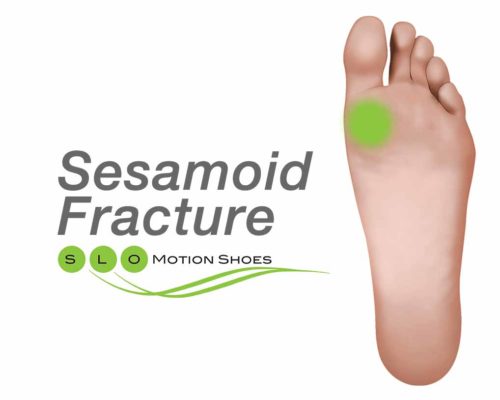The sesamoid, found in a number of joints in the body, is a bone embedded within a tendon. There are two small sesamoid bones located in your foot on the bottom of the big toe joint. Sometimes these bones fracture due to excessive pressure or forced bending.

Symptoms
- Pain in the ball of foot just behind big toe
- Pain comes on suddenly
- Intermittent swelling of the ball of the foot
- Pain during walking, running or jumping
- Pain or difficulty straightening and bending the big toe
Causes
- Activities that cause excessive pressure or forced bending of toe, such as dancing, running, or frequent squatting
- Age-related conditions, such as arthritis and osteochondritis
Treatment
Treatment is focused on reducing pressure and bending of big toe, promoting healing of area, and reducing pain.
- Over the counter pain medication, such as ibuprofen (Advil, Motrin) or naproxen (Aleve), as needed
- Immobilization with removable CAM boot
- Activity limitation / modification
- Orthotic device with padding
- Stiff soled shoe
- Tape the joint to limit movement of big toe
The sesamoids are two small bones located on the bottom of the big toe joint. The mere size of a lima bean these two bones help maintain stability of the big toe on the ground and are an integral part of the big toe joint function. Their prominent position on the bottom of the joint leaves them at risk for injury. Excessive pressure during walking or a forced bending injury can create inflammation. The “itis” in sesamoiditis refer to inflammation within the tissues surrounding the sesamoid bones. If the walking pressure or forced bending is large enough the sesamoid bones can break or fracture.
Differentiating Sesamoiditis from Sesamoid Fracture can be difficult. Swelling to the bottom of the big toe joint is not generally noted in sesamoiditis but can be quite pronounced with a fracture. Pain during walking in encountered in both conditions but the severity of pain may lean the diagnosis toward fracture. A fracture line may not be visible on a regular X-ray making necessary the use of an MRI study. The MRI although costly can be invaluable in differentiating these two problems. If a fracture is identified by examination as well as by radiographic study more aggressive immobilization is usually required to ensure adequate healing.
Whether treating sesamoiditis or a fracture, ice and anti-inflammatory medications may be helpful to relieve symptoms. A fracture will generally require immobilization to promote healing. Integral in the treatment of sesamoiditis however, is the temporary use of an orthotic device with padding applied to reduce pressure as well as a stiff soled shoe to reduce bending of the big toe. Combining the shoe and orthotic together decreases some of the harmful forces that cause the inflammation encountered in sesamoiditis.
Different treatment options are available including the use of custom orthotics, addition of a Morton’s extension, and the use of specialty shoes.







